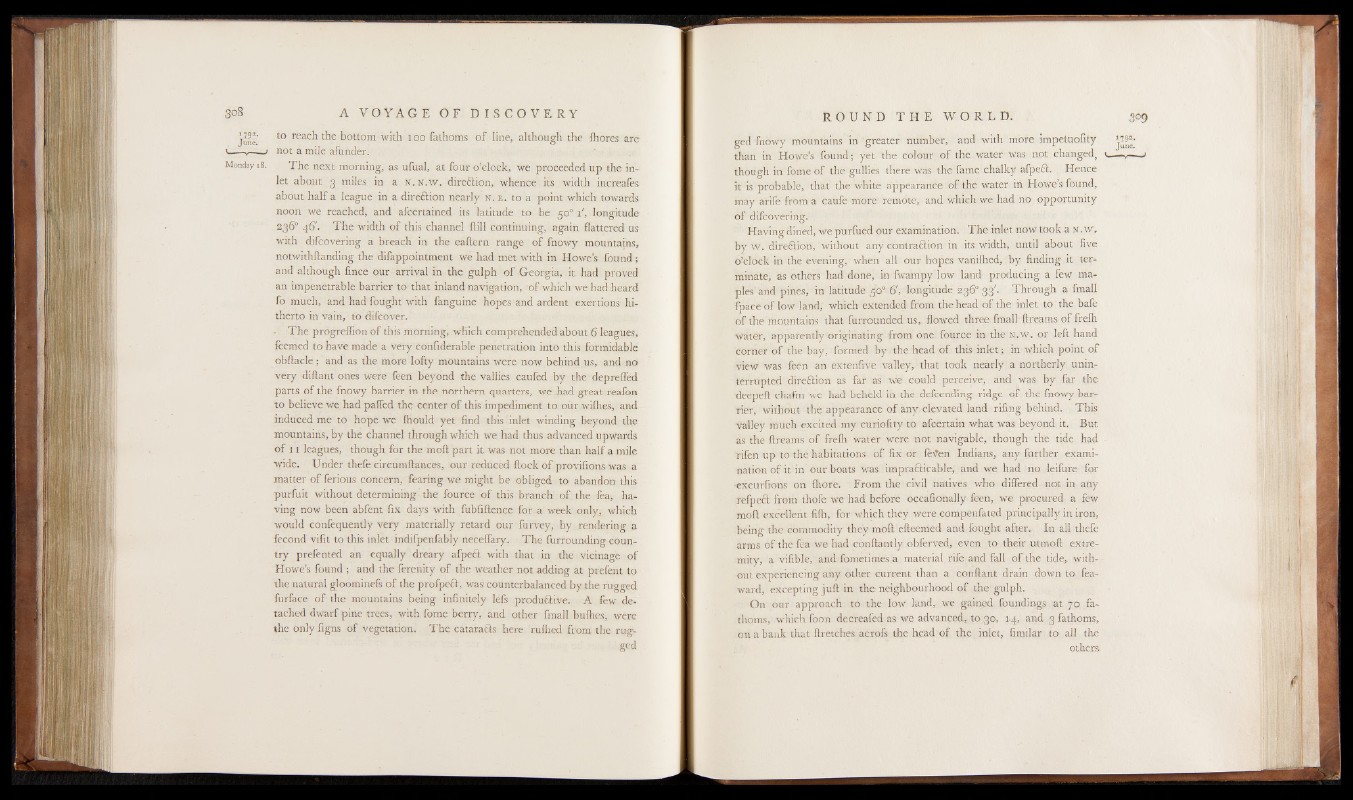
to reach the bottom with too fathoms o f line, although the fhores are
not a mile afunder.
The next morning, as ufual, at four o’clock, we proceeded up the inlet
about 3 miles in a N.N.w. direftion, whence its width increafes
about half a league in a direftion nearly n . e . to a point which towards
noon we reached, and afcertained its latitude to be 50° 1', longitude
236° 46'. The width of this channel {till continuing, again flattered us
with difcovering a breach in the eaftern range of fnowy mountains,
notwithftanding the difappointment we had met with in Howe’s found;
and although fince our arrival in the gulph of Georgia, it had proved
an impenetrable barrier to that inland navigation, of which we had heard
fo much, and had fought with fanguine hopes and ardent exertions hitherto
in vain, fo difcover.
• The progreflion o f this morning, which comprehended about 6 leagues,
feemed to have made a very conliderable penetration into this formidable
obflacle; and as the more lofty mountains were now behind us, and no
very diftant ones were feen beyond the vallies caufed by the depreffed
parts of the fnowy barrier in the northern quarters, we had great; reafon
to believe we had paffed the center of this impediment to our withes, and
induced me to hope we fliould yet find this inlet winding beyond the
mountains, by the channel through which we had thus advanced upwards
o f 11 leagues, though for the moft part it was not more than half a mile
wide. Under thefe circumftances, our reduced flock of provifions was a
matter of ferious concern, fearing we might be obliged to abandon this
purfuit without determining the fource of this branch of the fea, having
now been abfent fix days with fubfiftence for a week only, which
would confequently very materially retard our furvey, by rendering a
fecond vifit to this inlet indifpenfably neceffary. The furrounding country
prefented an equally dreary afpect with that in the vicinage of
Howe’s found ; and the ferenity of the weather not adding at prefent to
the natural gloominels of the profpeft, was counterbalanced by the rugged
furface of the mountains being infinitely lefs produftive. A few detached
dwarf pine trees, with fome berry, and other fmall bullies, were
the only figns of vegetation. The cataracts here rulhed from the rugged
ged fnowy mountains in 'greater number, and with more impetuofity D o than
in Howe’s found; yet the colour of the water was not changed, i— -v-— 1
though in fome of the gullies there was the fame chalky afpefl. Hence
it is probable, that the white appearance of the water in Howe’s found,
may arife from a Caufe more remote, and which we had no opportunity
of difcovering.
Having dined, we purfued our examination. The inlet now took a n .w ,
by w . direction, without any contraction in its width, until about five
o’clock in the evening, when all our hopes vanilhed, by finding. it terminate,
as others had done, in fwampy low land producing a few maples'and
pines, in latitude 50° 6', longitude 236° 33'. Through a fmall
fpace of low land, which extended from the head of the inlet to the bafe
o f the mountains that furrounded us,, flowed three fmall ftreams of frefh
water, apparently originating from one fource in the N.w. or left hand
corner of the bay, formed by the head of this inlet'; in which point o f
view was feen an extenfive valley, that took nearly a northerly uninterrupted
direftion as far as we could perceive, and was by far the
deepeft chafm we had beheld in the defeending ridge of the: fnowy barrier,
without the appearance o f any elevated land riling behind. This
valley much excited my curiofity to afeertain what was beyond it. But
as the ftreams of frefh water were not navigable, though the tide had -
rifen up to the habitations of fix or fotfen Indians, any further examination
of it in our boats was impraSicable, and we had no leifure for
■ excurftons on Ihore. From the civil natives who differed not in any
refpeft from thofe we had before oecafionally feen, we procured a few
moft excellent filh, for which they were compenfated principally in iron,
being the commodity they moft efteemed and fought after. In all thefe
arms of the fea we had conftantly obferved, even to their utmoft extremity,
a vifible, and fometimes a material rife and fall of the tide, with--
out experiencing any other current than a conftant drain down to fea-
ward, excepting juft in the neighbourhood of the gulph.
On our approach to the low land, we gained foundings at 70 fathoms,
which foon decreafed as we advanced, to 30, 14, and 3 fathoms,
on a bank that ftretches acrofs the head of the, inlet, fimilar to all the